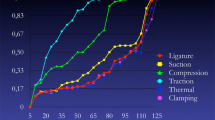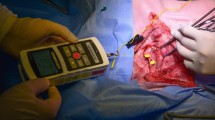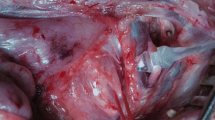Abstract
Purpose
Recurrent laryngeal nerve palsy in thyroid surgery is still a threatening complication. Our aim was to analyze the impact of prolonged tensile stress on the recurrent laryngeal nerve (RLN) in an animal model using continuous intraoperative neuromonitoring (C-IONM).
Methods
Constant tensile stress was applied to left and right RLNs in 20 pigs (40 RLN). In a pilot study, five animals were subjected to a tensile force of 0.34 ± 0.07 N for 10 min and changes in amplitude were documented using C-IONM. In the main study, a force of 1.2 N was applied until the signal amplitude was reduced by 85 %, in 15 pigs. Nerve conductivity was analyzed by threshold current measurements.
Results
Good correlation was found between stress and amplitude decrease in the pilot study as well as between signal decrease and duration of trauma in the main study. Great variations were found inter- and intra-individually. These variations were most prominent at 85 % signal reduction (median 36 min, range 0.3–171 min). There was no side specificity (left 0.3–171 min, right 0.3–168 min, respectively, p = 0.19). However, in each individual animal, there was a sensitive (0.3–98.9 min) and less sensitive nerve (26.8–171 min). These differences became highly significant at 85 % of signal reduction (p = 0.008), where the vulnerability is 1.4 to 146.4 times higher on one side (mean 4.3).
Conclusions
Our study demonstrates the presence of a sensitive RLN that was 4.3 times more vulnerable than the contralateral nerve (range 1.4–146.4 times, p = 0.008). Thus, the right and the left nerves cannot be assumed to be of equal sensitivity to trauma. In our data, the more sensitive nerve does not occur predominantly on one side and was named the “weepy nerve.”










Similar content being viewed by others
References
Serpell JW, Lee JC, Yeung MJ, Grodski S, Johnson W, Bailey M (2014) Differential recurrent laryngeal nerve palsy rates after thyroidectomy. Surgery 156:1157–66. doi:10.1016/j.surg.2014.07.018
Bures C, Bobak-Wieser R, Koppitsch C, Klatte T, Zielinski V, Freissmuth M et al (2014) Late-onset palsy of the recurrent laryngeal nerve after thyroid surgery. Br J Surg 101:1556–59. doi:10.1002/bjs.9648
Smith J, Douglas J, Smith B, Dougherty T, Ayshford C (2014) Assessment of recurrent laryngeal nerve function during thyroid surgery. Ann R Coll Surg Engl 96:130–35. doi:10.1308/003588414X13814021676594
Hardman JC, Smith JA, Nankivell P, Sharma N, Watkinson JC (2015) Re-operative thyroid surgery: a 20-year prospective cohort study at a tertiary referral centre. Eur Arch Otorhinolaryngol 272:1503–08. doi:10.1007/s00405-014-3068-5
Roh J, Kim J, Park CI (2011) Central compartment reoperation for recurrent/persistent differentiated thyroid cancer: patterns of recurrence, morbidity, and prediction of postoperative hypocalcemia. Ann Surg Oncol 18:1312–18. doi:10.1245/s10434-010-1470-9
Karamanakos SN, Markou KB, Panagopoulos K, Karavias D, Vagianos CE, Scopa CD et al (2010) Complications and risk factors related to the extent of surgery in thyroidectomy. Results from 2,043 procedures. Hormones (Athens) 9:318–25
Patow CA, Norton JA, Brennan MF (1986) Vocal cord paralysis and reoperative parathyroidectomy. A prospective study. Ann Surg 203(3):282–5
Lo CY, Kwok KF, Yuen PW (2000) A prospective evaluation of recurrent laryngeal nerve paralysis during thyroidectomy. Arch Surg 135(2):204–7
Zambudio AR, Rodríguez J, Riquelme J, Soria T, Canteras M, Parrilla P (2004) Prospective study of postoperative complications after total thyroidectomy for multinodular goiters by surgeons with experience in endocrine surgery. Ann Surg 240:18–25
Rosato L, Carlevato MT, de Toma G, Avenia N (2005) Recurrent laryngeal nerve damage and phonetic modifications after total thyroidectomy: surgical malpractice only or predictable sequence? World J Surg 29:780–84. doi:10.1007/s00268-005-7653-z
Serpell JW, Lee JC, Chiu WK, Edwards G. Stressing the recurrent laryngeal nerve during thyroidectomy. ANZ J Surg. 2015 DOI: 10.1111/ans.13054.
Dionigi G, Boni L, Rovera F, Rausei S, Castelnuovo P, Dionigi R (2010) Postoperative laryngoscopy in thyroid surgery: proper timing to detect recurrent laryngeal nerve injury. Langenbecks Arch Surg 395(4):327–31
Hayward NJ, Grodski S, Yeung M, Johnson WR, Serpell J (2013) Recurrent laryngeal nerve injury in thyroid surgery: a review. ANZ J Surg 83(1-2):15–21
Menorca RMG, Fussell TS, Elfar JC (2013) Nerve physiology: mechanisms of injury and recovery. Hand Clin 29:317–30. doi:10.1016/j.hcl.2013.04.002
Lamadé W, Meyding-Lamadé U, Hund E, Senninger N, Herfarth C (1997) Transtracheales Monitoring des Nervus laryngeus recurrens. Der Prototyp eines neuen Tubus. Chirurg 68:193–95
Lamadé W, Brandner R, Brauer M, Hund E, Klar E, Herfarth C (1998) Continuous monitoring of the recurrent laryngeal nerve. Langenbecks Arch Chir Suppl Kongressbd 115:1055–7
Lamadé W, Meyding-Lamadé U, Buchhold C, Brauer M, Brandner R, Uttenweiler V et al (2000) Erstes kontinuierliches Nerven-Monitoring in der Schilddrüsenchirurgie. Chirurg 71:551–57
Lamadé W, Ulmer C, Seimer A, Molnar V, Meyding-Lamadé U, Thon K et al (2007) A new system for continuous recurrent laryngeal nerve monitoring. Minim Invasive Ther Allied Technol 16:149–54. doi:10.1080/13645700701383241
Lamadé W, Ulmer C, Friedrich C, Rieber F, Schymik K, Gemkow HM et al (2011) Signalstabilität als Grundvoraussetzung für kontinuierliches intraoperatives Neuromonitoring. Chirurg 82:913–20. doi:10.1007/s00104-011-2080-1
Friedrich C, Ulmer C, Rieber F, Kern E, Kohler A, Schymik K, Thon KP, Lamadé W (2012) Safety analysis of vagal nerve stimulation for continuous nerve monitoring during thyroid surgery. Laryngoscope 122(9):1979–87
Dionigi G, Donatini G, Boni L, Rausei S, Rovera F, Tanda ML et al (2013) Continuous monitoring of the recurrent laryngeal nerve in thyroid surgery: a critical appraisal. Int J Surg 11(Suppl 1):S44–6. doi:10.1016/S1743-9191(13)60014-X
Schneider R, Randolph GW, Sekulla C, Phelan E, Thanh PN, Bucher M et al (2013) Continuous intraoperative vagus nerve stimulation for identification of imminent recurrent laryngeal nerve injury. Head Neck 35:1591–98. doi:10.1002/hed.23187
Schneider R, Sekulla C, Machens A, Lorenz K, Nguyen Thanh P, Dralle H (2015) Postoperative vocal fold palsy in patients undergoing thyroid surgery with continuous or intermittent nerve monitoring. Br J Surg 102:1380–87. doi:10.1002/bjs.9889
Randolph GW, Kamani D (2014) Intraoperative neural monitoring in thyroid cancer surgery. Langenbecks Arch Surg 399:199–207. doi:10.1007/s00423-013-1141-y
Wu C, Dionigi G, Sun H, Liu X, Kim HY, Hsiao P et al (2014) Intraoperative neuromonitoring for the early detection and prevention of RLN traction injury in thyroid surgery: a porcine model. Surgery 155:329–39. doi:10.1016/j.surg.2013.08.015
Puram SV, Chow H, Wu C, Heaton JT, Kamani D, Gorti G, et al. Vocal cord paralysis predicted by neural monitoring electrophysiologic changes with recurrent laryngeal nerve compressive neuropraxic injury in a canine model. Head Neck. 2015 DOI: 10.1002/hed.24225.
Authors’ contributions
Wolfram Lamadé Prof. Dr. med.
Maren Béchu M.Sc.
Ester Lauzana Dr. med.
Peter Köhler Dr. rer. Nat.
Sabine Klein Dr. agr. Ing.
Tuncay Tuncer
Noor Isra Heryantee Rashid M.D.
Erich Kahle
Bertram Erdmann
Uta Meyding-Lamadé Prof. Dr. med.
Study concept and design
Wolfram Lamadé Prof. Dr. med.
Maren Béchu M.Sc.
Ester Lauzana Dr. med.
Peter Köhler Dr. rer. Nat.
Noor Isra Heryantee Rashid M.D.
Uta Meyding-Lamadé Prof. Dr. med.
Acquisition of data
Maren Béchu M.Sc.
Ester Lauzana Dr. med.
Peter Köhler Dr. rer. Nat.
Tuncay Tuncer
Sabine Klein Dr. agr. Ing.
Erich Kahle
Analysis and interpretation of data
Maren Béchu M.Sc.
Wolfram Lamadé Prof. Dr. med.
Tuncay Tuncer
Sabine Klein Dr. agr. Ing.
Bertram Erdmann
Drafting of manuscripts
Wolfram Lamadé Prof. Dr. med.
Maren Béchu M.Sc.
Sabine Klein Dr. agr. Ing.
Critical revision of manuscript
Wolfram Lamadé Prof. Dr. med.
Maren Béchu M.Sc.
Uta Meyding-Lamadé Prof. Dr. med.
Author information
Authors and Affiliations
Corresponding author
Ethics declarations
Conflict of interest
The authors declare that they have no conflicts of interest.
Sources of financial support
HELIOS Kliniken GmbH grant-ID: 005837
Additional information
Wolfram Lamadé and Maren Béchu as joint First Authors
Rights and permissions
About this article
Cite this article
Lamadé, W., Béchu, M., Lauzana, E. et al. The weepy nerve—different sensitivity of left and right recurrent laryngeal nerves under tensile stress in a porcine model. Langenbecks Arch Surg 401, 983–990 (2016). https://doi.org/10.1007/s00423-016-1439-7
Received:
Accepted:
Published:
Issue Date:
DOI: https://doi.org/10.1007/s00423-016-1439-7




